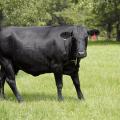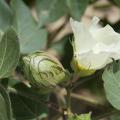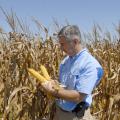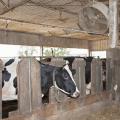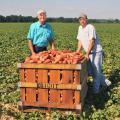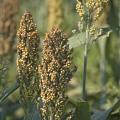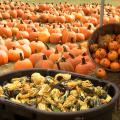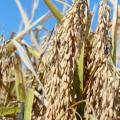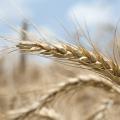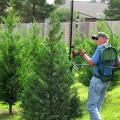Crop Report from 2013
MISSISSIPPI STATE – Forage producers and their livestock are not the only ones admiring the plentiful bermudagrass fields and pastures across the state this year.
Another invasive insect has arrived in Mississippi, this time to take a bite out of potentially strong hay yields. Stem maggots are joining the list of invasive species in the state that includes fire ants, fall armyworms, kudzu bugs, and once upon a time, boll weevils.
MISSISSIPPI STATE – Rains are taking some feed-cost pressure off Mississippi cattle producers as the end of summer approaches.
Jane Parish, beef specialist with the Mississippi State University Extension Service, said summer droughts often reduce hay yields, and the resulting sparse grass in pastures can trigger hay feedings before the first frost hits. This year, rains across most of the state have had the opposite effect and kept grass abundant.
MISSISSIPPI STATE – Mississippi’s cotton growers are hoping weather challenges don’t prevent their late-planted crop from making the good yields it seems capable of producing.
Darrin Dodds, state cotton specialist with the Mississippi State University Extension Service, said the bulk of the crop was in pretty decent shape by late August.
“Some folks feel they are sitting on one of the better crops they’ve had,” he said. “All that will boil down to the weather we have in the fall. We need a long, favorable fall, and the heat to stick with us and the rain to stay away.”
MISSISSIPPI STATE -- This year’s rainy spring kept grass from growing, but it also kept contractors from building, allowing Mississippi’s sod farmers to manage the season’s rough beginning.
Barry Stewart, turf management specialist with the Mississippi State University Extension Service and Mississippi Agricultural and Forestry Experiment Station, said demand was low at a time that benefitted growers.
MISSISSIPPI STATE -- Mississippi growers’ determination to plant corn last spring is paying off as harvests approach 2012’s record yields of 165 bushels per acre.
Persistent rains and low temperatures in the spring delayed planting, slowed emergence and contributed to less than desirable final stands. Cool weather through May also slowed corn growth and maturity by about two weeks throughout the season.
Jerry Singleton, area agent in Leflore County with the Mississippi State University Extension Service, said he is almost afraid to say how good the yields appear to be.
MISSISSIPPI STATE – 2013 continues the trend of high feed prices, making it very challenging for Mississippi dairy farms to make a profit.
Lamar Adams, dairy specialist with the Mississippi State University Extension Service, said prices farmers are paid for their milk have been higher than in recent years, but feed prices have remained much higher than ever before.
MISSISSIPPI STATE – Mississippi swine producers are discovering the only constant in their industry is change.
John Michael Riley, agricultural economist with the Mississippi State University Extension Service, said a variety of challenges have kept the state’s swine producers adjusting their strategies to avoid financial losses in recent decades. Just when producers adjust to overcome one hurdle, another one develops to drive prices down and the cost of production up.
MISSISSIPPI STATE -- In spite of recent rains, the state’s sweet potato growers have a lot to be excited about this harvest season.
“Growers set the majority of the crop back in late May and June under ideal conditions,” said Stephen Meyers, sweet potato specialist with the Mississippi State University Extension Service. “We had good root set, which means the number of roots per plant has been good.”
MISSISSIPPI STATE -- Mississippi’s farmers showed their ability to adapt when wet spring weather forced many of them to change their planting intentions from corn, cotton and soybeans to late-planted grain sorghum.
MISSISSIPPI STATE – The cool, damp nights that are making it feel like fall in Mississippi are slowing peanut harvests way down across much of the state.
Mississippi’s peanut crop was 28 percent harvested as of the last U.S. Department of Agriculture Crop Progress and Condition Report released Sept. 30. Because of the federal government shutdown, no new figures have been released in almost two weeks. At the end of September, 48 percent of the crop was listed in good condition, with 13 percent excellent and 39 percent fair.
MISSISSIPPI STATE – Mississippi’s pumpkins have experienced something of a holiday miracle with one of their best seasons ever.
David Nagel, horticulturist with the Mississippi State University Extension Service, said 2013 has been the best year for pumpkins since he started working in the state about 25 years ago. Mississippi growers are producing more and larger pumpkins than their competitors in states to the north.
MISSISSIPPI STATE – After a late start for the planting season raised fears that a hot August could damage the crop, Mississippi’s rice has yielded a high-quality harvest.
The Oct. 20 U.S. Department of Agriculture crop progress and condition report indicated the state’s rice crop was 96 percent harvested. The crop’s quality was rated as 50 percent good and 25 percent excellent.
Tim Walker, rice agronomist with the Mississippi State University Extension Service, said grain quality is based on several factors, including translucence.
MISSISSIPPI STATE – Fall planting of the state’s winter wheat crop is on schedule, and early-season growth looks good in fields planted so far.
According to the U.S. Department of Agriculture’s Oct. 27 report, 28 percent of the state’s expected wheat crop had been planted. Unlike spring, when all row crops were well behind schedule, this estimate puts wheat exactly on track with the five-year average.
By Kaitlyn Byrne
MSU Ag Communications
MISSISSIPPI STATE – Thanks to impressive live Christmas tree sales last year, customers seeking the best Christmas trees may need to buy early this year.


